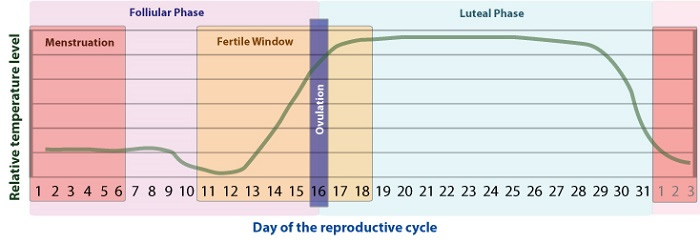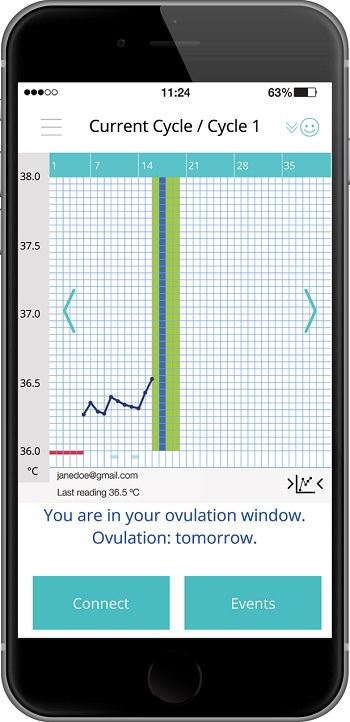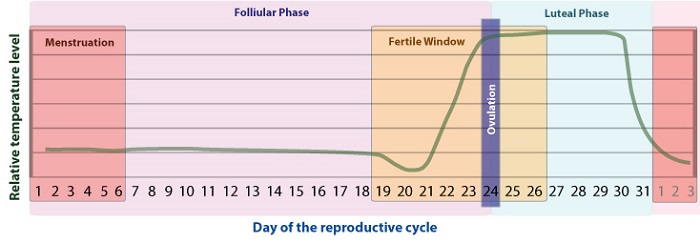Positive Health Online
Your Country

Take Control of your Fertility by Understanding your Luteal Phase
by Robert Milnes and Kate Davies(more info)
listed in fertility, originally published in issue 245 - April 2018
Deciding to have a child is an exciting time for any couple. But, for the 3.5 million women who suffer from fertility issues (NHS Statistics), it can quickly turn to disillusion and heartache. In 70% of cases, a woman may become pregnant naturally within six months, if she is trying every few days (NHS Statistics). But for the remaining 30%, there may be an underlying fertility issue that is making things difficult.
Making matters worse, difficulty getting pregnant and fertility worries pile on stress, making it even more difficult to conceive (Buck Louis et al.). It can feel like a downward spiral with no chance of escape. Fortunately, there are steps you can take to understand your cycle and ovulation that can improve your chances of getting pregnant.
The Reproductive Cycle
The first phase of your reproductive cycle starts at the end of your period and is known as the follicular phase. This is when an egg matures in the ovaries in small sacks known as follicles. Once the egg has fully matured it breaks out of the follicle and begins its journey down the fallopian tubes to the uterus - this is the process of ovulation. As the sperm can survive for around a week after they are released, and the egg has a life of around 24 hours after ovulation occurs, clinical studies (Colombo et al. and others) show that a couple should be trying to conceive from 5 days before ovulation up until 2 days after the predicted day of ovulation - this is known as the fertile window. During this window the sperm needs to meet the egg on its journey through the fallopian tubes in order for it to be fertilized.

31-day cycle middle of the month ovulation
Many women are led to believe that ovulation always occurs in the middle of their 28-day cycle, i.e. around day 14. However, studies (e.g. Baird et al.) have shown that only 30% of women ovulate between days 10 and 17, with the majority of women reaching their fertile window earlier, but some much later.
Ovulating either later or earlier in your cycle isn’t necessarily a concern, but knowing exactly when ovulation occurs is crucial in order to maximize your chances of conception. Even a day out could mean you miss your fertile window and not conceive.
Next comes the luteal phase - the time between an egg being released and your period (assuming the egg is not fertilized) - where the lining of your uterus becomes thicker. Understanding your body during this critical time can help increase your chances of conceiving and lower your chances of miscarriage.
If the egg is fertilized it will implant in the lining of the uterus - known as the endometrium - and start to develop. If the egg is not fertilized it will be excreted.
The final phase of your cycle is menstruation, where the endometrium is discharged from the uterus, and the cycle begins again.
Predicting and Detecting Ovulation
Ovulation Predictor Kits (OPKs)
As ovulation doesn’t happen at the same time for everyone, many women will use ovulation prediction kits (OPKs) to try and predict ovulation. OPKs test for an increase in the luteinizing hormone (known as an LH Surge) which typically occurs 24-48 hours prior to ovulation. However, research has shown that the timing and duration of an LH surge varies drastically between women (Direito et al.), making it an unreliable predictor of when to try and conceive.
The percentage of false negatives (when the OPK gives no positive indication but you are actually about to ovulate) ranges from 9% (Lloyd et al.) to 35% (Arici et al.) depending on the study, and the number of false positives (saying you are about to ovulate when you’re actually not) is 7.7%, according to McGovern et al. This is likely to happen if you have Polycystic Ovaries (PCO) and/or Polycystic Ovarian Syndrome (PCOS), as your LH may be higher at times in the month when no ovulation is likely to happen (Robinson et al.). OPKs cannot confirm that ovulation actually happened so they are not used for detection of the date of ovulation.
Temperature
One way of detecting the ovulation date includes measuring subtle changes in body temperature. A woman’s body temperature increases slightly as progesterone is released during the process of ovulation. This change can be measured externally using an oral thermometer or on the skin. The problem with this method is that external temperature lags the action of progesterone on the ovaries associated with ovulation so they can only be used to detect ovulation after it has happened - of very little use to women with variable ovulation. Studies show they also give false date of ovulation result around 20% of the time (Freundl et al.; Rollason et al.).

Ovulation-Tomorrow-on-iPhone
This is what led to the development of OvuSense - a fertility monitor which uses a vaginal sensor to track core body temperature over time. This method enables OvuSense to ‘see’ the temperature rise as soon as progesterone is released, and it can be used to predict ovulation, in real-time, in cycle, and provide 99% accuracy in detecting the date of ovulation (with clinical proof published Papaioannou et. al.). The OvuSense Sensor sits in the vagina like a tampon overnight and can monitor changes in temperature against your own baseline and exclude all the noise and variability in the signal associated with measuring externally.
Other Methods
Other ways of predicting and detecting ovulation include ultrasound and testing blood progesterone levels, but both require a medical professional and need to be taken a number of times over the cycle to be accurate, making them costly, inconvenient and time-consuming.
Understanding Your Luteal Phase
Even if you know when you are ovulating, it still may not be clear why you are struggling to conceive. A common issue is luteal phase Deficiency (LPD), which generally means the lining of your uterus doesn’t develop sufficiently to support the fertilized egg, making it difficult to sustain a pregnancy making miscarriage more likely. If your ovaries don't release enough of the hormone progesterone, or if the lining of your uterus doesn't respond to the hormone, you could suffer from LPD.

31-day cycle late ovulation / short luteal phase
One of the most obvious signs of LPD is a short luteal phase - an ovulation that occurs nine days or less before the subsequent onset of menstruation - meaning that the uterus lining doesn’t have enough time to thicken in order to support the fertilized egg. So knowing your date of ovulation is key to determining your luteal phase length. The tests which detect ovulation outlined above can be useful, especially if used over a number of cycles, but the more accurate the test, the more likelihood there is of pinpointing the problem sooner.
Although a short luteal phase is a common way of determining LPI it occurs in up to 5% of healthy fertile women, and not all women with LPD have a short luteal phase, so the length of the luteal phase alone is an imperfect diagnosis. Mesen and Young established that – as a result - there is no standard diagnosis or testing for LPD, although there are a number of signs health conditions which are connected with LPD. Hyperprolactinemia (too much of the hormone responsible for producing breast milk), hyper-luteinizing hormone, endometriosis, thyroid problems, PCO/PCOS, as well as things like stress, anorexia, obesity, and extreme amounts of exercise (Aisaka et al.; Ji; Buck Louis et al.) have all be shown to link to LPD.
One proposed diagnostic test has been to measure the progesterone level in the blood during the luteal phase. However, as with determining ovulation, this type of testing is flawed because it only shows the level at a ‘snapshot’ in time. Measuring fluctuations in the level of progesterone over the whole luteal would be ideal and OvuSense is now working on the clinical proof which would allow it to be used as a standard test for LPD - both in determining the length of the luteal phase accurately (which it already can do) but also in determining what is happening to the level of progesterone.
Whatever your current cycle pattern, if you notice you have a short luteal phase it’s important to seek clinical advice and treatment. The good news is, if you treat the underlying issue, you can often correct it.
https://www.youtube.com/watch?v=9mM62xBSxE8
Kate Davies, an independent Fertility Nurse, shares her thoughts on OvuSense compared with OPKs and BBT
About OvuSense
OvuSense is a real-time fertility monitor App and Sensor that predicts ovulation with a positive predictive value of 96% and detects the exact date of ovulation with clinically proven 99% clinically proven accuracy. The OvuSense Sensor fits easily in a vagina, similar to a tampon, and has proven comfortable for women in over 20,000 cycles of use. The sensor does not transmit radio waves from within the body, so it’s completely safe to use.
Inserted before sleep, the sensor takes a reading of the woman’s 'core body' temperature every five minutes, all night long, to provide an extremely accurate average daily temperature measurement using a patented algorithm.
Data are downloaded each morning to show the ovulation cycle pattern.
A brand-new version of the accompanying iOS/Android app allows users to view their data in raw, smooth or combined graph types, giving the user a much better understanding of the calculations and messages OvuSense provides. The app also gives users the ability to sign-up clinicians, partners, family and friends in order to share charts. All raw data are encrypted, uploaded and stored in a dedicated and secure cloud database.
OvuSense Online
www.ovusense.com www.facebook.com/OvuSense twitter.com/OvuSense
References and Bibliography
Aisaka, K., Yoshida, K., Mori, H. Analysis of clinical backgrounds and pathogenesis of luteal-phase defect. Hormone Research 37(1):41-7. 1992
Arici, A., Carr, BR., Comparison of two LH monitoring methods in women undergoing intrauterine insemination. Proceedings of the 48th Annual Meeting of the American Fertility Society. 1992
Baird, D., McConnaughey, D., Weinberg, C., Musey, P., Collins, D., Kesner, J., Knecht, E., Wilcox, A. Application of a Method for Estimating Day of Ovulation Using Urinary Estrogen and Progesterone Metabolites. Epidemiology, 6(5): 547-550. 1995
Buck Louis, G.M., Lum, K.J., Sundaram, R., Chen, Z., Kim, S., Lynch, C.D. Schisterman, E.F., Pyper, C. Stress reduces conception probabilities across the fertile window: evidence in support of relaxation. Fertility and Sterility, 95(7); 2184-2189. 2011
Colombo B, Masarotto G (2000) Daily fecundability: first results from a new data base. Demogr Res. 3:39
Direito, Ana et al. Relationships between the luteinizing hormone surge and other characteristics of the menstrual cycle in normally ovulating women. Fertility and Sterility, 99(1): 279-285. 2013
Freundl, G., Godehardt, E., Kern, P.A., Frank‐Herrmann, P., Koubenec, H.J., Gnoth, Ch. Estimated maximum failure rates of cycle monitors using daily conception probabilities in the menstrual cycle. Human Reproduction, 18(12): 2628–2633. 2003
Ji, H., [Luteal function in patients with endometriosis] [Translated from Chinese]. Zhongguo Yi Xue Ke Xue Yuan Xue Bao. 11(5): 344-8. 1989
Lloyd, R., Coulman, CB., The accuracy of urinary luteinising hormone testing in predicting ovulation. Am J Obstet Gynecol, 60: 1370-2. 1989
McGovern, P., Myers, E., Silva, S., Coutifaris, C., Carson, S., Legro, R., Schlaff, W., Carr, B., Steinkampf, M., Giudice, L., Leppert, P., Diamond, M.; NICHD National Cooperative Reproductive Medicine Network. Absence of secretory endometrium after false-positive home urine luteinizing hormone testing. Fertil Steril 82(5): 1273-7. 2004
Mesen, T., Young, S.; Progesterone and the Luteal Phase: A Requisite to Reproduction. Obstet Gynecol Clin North Am. 2015 March ; 42(1): 135–151. doi:10.1016/j.ogc.2014.10.003
NHS Statistics: https://www.nhs.uk/conditions/infertility/ Recovered on 10th January, 2018
Papaioannou, S., Aslam, M. Ovulation assessment by vaginal temperature analysis (Ovusense Fertility Monitoring System) in comparison to oral temperature recording. American Society for Reproductive Medicine 68th Annual conference. 2012
Papaioannou, S., Aslam, M. Ovulation Assessment and Fertile Period Prediction by Portable Computerised Vaginal Temperature Analysis – The OvuSense Advanced Fertility Monitoring System. European Society of Human Reproduction and Embryology 28th Annual Conference. 2012
Robinson, S., Rodin, DA., Which hormone tests for the diagnosis of polycystic ovary syndrome? Br J Obstet Gynaecol 99(3): 232–238. 1992
Rollason, J.C., Outtrim, J.G., Mathur, R.S. A pilot study comparing the DuoFertility(®) monitor with ultrasound in infertile women. International Journal of Women’s Health. 16(6): 657-62. 2014
Comments:
-
No Article Comments available